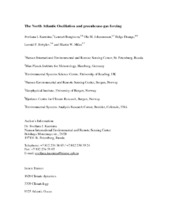| dc.contributor.author | Kuzmina, Svetlana I. | eng |
| dc.contributor.author | Bengtsson, Lennart | eng |
| dc.contributor.author | Johannessen, Ola M. | eng |
| dc.contributor.author | Drange, Helge | eng |
| dc.contributor.author | Bobylev, Leonid P. | eng |
| dc.contributor.author | Miles, Martin W. | eng |
| dc.date.accessioned | 2005-03-09T14:03:05Z | |
| dc.date.available | 2005-03-09T14:03:05Z | |
| dc.date.issued | 2005-02-17 | eng |
| dc.Published | Geophysical Research Letters 2005 32:(4) | en |
| dc.identifier.issn | 0094-8276 | en_US |
| dc.identifier.uri | https://hdl.handle.net/1956/626 | |
| dc.description.abstract | The results of 12 coupled climate models participating in the Coupled Model Intercomparison Project (CMIP2) are compared together with observational data in order to investigate: 1) How the current generation of climate models reproduce the major features of the winter North Atlantic Oscillation (NAO), and 2) How the NAO intensity and variability may change in response to increasing atmospheric CO2 concentration. Long-term changes in the intensity and spatial position of the NAO nodes (Icelandic Low and Azores High) are investigated, and different definitions of the NAO index and the Arctic Oscillation (AO) are considered. The observed temporal trend in the NAO in recent decades lies beyond the natural variability found in the model control runs. For the majority of the models, there is a significant increase in the NAO trend in the forced runs relative to the control runs, suggesting that the NAO may intensify with further increases in greenhouse-gas concentrations. | en_US |
| dc.format.extent | 490994 bytes | eng |
| dc.format.mimetype | application/pdf | eng |
| dc.language.iso | eng | eng |
| dc.publisher | American Geophysical Union | en_US |
| dc.subject | Climate dynamics | eng |
| dc.subject | Climatology | eng |
| dc.title | The North Atlantic Oscillation and greenhouse-gas forcing | en_US |
| dc.type | Peer reviewed | |
| dc.type | Journal article | |
| dc.identifier.doi | https://doi.org/10.1029/2004gl021064 | |
